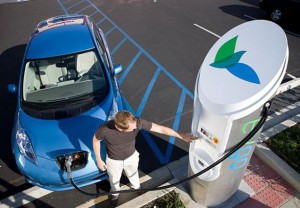 Back in 2000, rolling blackouts descended upon California and eventually cost Governor Gray Davis his job. The crisis was caused by deviant corporate behavior, and one of the companies involved, NRG, finally settled with the state in 2012 for damages related to its conduct. But instead of being punished, the California Public Utilities Commission allowed NRG to commit to spending $100 million on electric vehicle public charging infrastructure, essentially helping the company invest in a new business venture.
Back in 2000, rolling blackouts descended upon California and eventually cost Governor Gray Davis his job. The crisis was caused by deviant corporate behavior, and one of the companies involved, NRG, finally settled with the state in 2012 for damages related to its conduct. But instead of being punished, the California Public Utilities Commission allowed NRG to commit to spending $100 million on electric vehicle public charging infrastructure, essentially helping the company invest in a new business venture.
It was a controversial bargain, but the upshot for the state was a big injection of capital into badly needed electric vehicle infrastructure. With 65,000 electric vehicles now on the road in California, the competition is increasing for charging stations. The NRG settlement would result in at least 200 new publicly available fast-charging stations around the state, as well as wiring for 10,000 more charging stations in offices, homes, and other public and private spaces.
So how is implementation going? Not well. NRG’s new subsidiary to build these stations, eVgo, is way behind schedule, with only 13 fast-charging stations open out of the 200 that need to be ready by 2016, with 100 of those to be open by the end of this year under the settlement terms. The company cites the startup pains associated with trying to get new infrastructure built – finding amenable site hosts, upgrading local utility wiring and equipment, and clearing the necessary permits. They believe they will make up for lost time this year.
But much of the reason for the delay is the basic conflict of interest involved in this settlement, which allows eVgo to site charging stations in crowded, complicated, and suboptimal urban areas in order to maximize the company’s profits. To be truly effective, expensive fast-charging stations (which can repower a battery to 80% capacity in just 20 minutes) should instead be located between cities and popular destinations, replicating the interstate gas stations drivers rely on for longer trips. These sites allow drivers to extend the range of their all-battery vehicles when they’re driving between cities like San Francisco and Sacramento, Los Angeles and San Diego/Palm Springs/Santa Barbara, or Fresno to Bakersfield, to name a few. For a good example of successful (and speedy) fast-charger deployment, look no further than Tesla and its optimally located Supercharger network along well-traveled interstates (enabling even an all-electric cross-country road trip).
On the other hand, fast-charging stations in urban areas tend to be a waste of money and counter-productive. Most city visitors live or work within 20 or 30 miles, meaning that a full charge over a regular wall outlet at the home or office should be sufficient to get them into the city and back in a typical 85 mile-range electric vehicle. And if they do need to charge downtown, these drivers usually don’t need a 20 minute fast charge because they are there to work or shop for at least one or two hours anyway. For this time frame, a cheaper “Level 2” 240V station will do just fine. What’s worse, crowded downtown fast chargers often require drivers to wait in line, defeating the purpose of a “fast” charge.
So why doesn’t eVgo/NRG follow this more sensible interstate model instead of trying to site their stations in suboptimal urban areas? Part of the answer lies in the settlement, which prescribes regions of the state for deployment. But the larger problem is that the company has a business interest in trying to make money off these stations through repeat customer membership deals and from patronage at nearby retail options. That’s why the company is working with upscale businesses, like Whole Foods and Urban Outfitters, and selling membership deals to hook local drivers into subscribing and becoming captive customers who will shop near the stations. This is a waste of charging infrastructure and a probable money-loser for NRG to boot.
If California was serious about making NRG pay for its rolling blackout damages and truly benefitting electric vehicle drivers, state leaders would insist that the fast-charging stations go in interstate locations, a la Tesla, to facilitate extended range for all-battery electric vehicle drivers. These locations should be the first priority, and they should blanket the state between our cities, not within them, and certainly not next to the local Whole Foods.
Were NRG representatives to take that approach, they’d find it a lot simpler to get these stations installed and ready. Sure, it wouldn’t help the company’s bottom line as much, but it would best serve the electric vehicle drivers of California.
3 thoughts on “California’s Flawed Approach to Electric Vehicle Public Charging”
-
Pingback: BMW And Volkswagen Team Up For Big EV Charging Deployment On West And East Coasts | Ethan Elkind
-
Pingback: The Dysfunction Of Fast-Charging Electric Vehicles In California | Ethan Elkind
-
Pingback: California Regulators Approve New Utility EV Charging But Fail To Monitor Existing $100M Investment | Ethan Elkind
Comments are closed.


